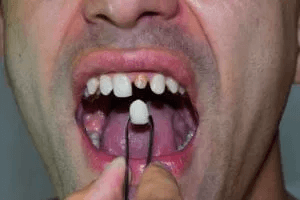While tooth enamel is extremely strong, it is not indestructible. Consequently, this can mean that teeth can become damaged from things like hard foods, nail-biting, pen chewing, and using your mouth to open packages. Teeth can also become damaged as a result of car accidents, sports accidents, or just accidents in general. No matter what the cause of the damage, once your tooth is broken, you will need to see a dentist to have it fixed.

If the damage is minimal, you may think that it is not necessary to repair the affected tooth. However, failing to repair a broken tooth can cause problems later down the line. For starters, a broken tooth is structurally compromised and may become more damaged. Additionally, bacteria could work their way inside the tooth through the damaged area, which can result in a pulp infection. Pulp infections cannot be reversed and the only treatment is to perform a root canal.
For these reasons, you should visit your dentist if you have a broken tooth. Depending on the location and severity of the damage, your dentist may recommend a variety of treatment options. The most popular ways to fix a broken tooth are veneers, crowns, and bonding.
Veneers
Veneers use thin shells made of porcelain or composite to fix a broken tooth. These shells are adhered to the front surface of the tooth to maintain an aesthetic appearance. They are intended to blend with the surrounding teeth, so you can have a single veneer placed to repair a broken tooth. They work well to repair minor cracks or chips, however more significant damage may require another method. Additionally, veneers are only applied towards the front of the mouth and are not an ideal option for molars.
Cosmetic Bonding
Cosmetic bonding, also called dental bonding or composite bonding, bonds composite resin to the tooth’s surface to repair chips or cracks. Composite resin is a dental material known for its ability to form strong bonds with enamel, as well as its ability to be color-matched. It can be used to fix moderate tooth damage and is sometimes also used in coordination with other restoration methods to fix significant damage.

Crowns
A crown is a tooth-shaped cap that is placed over the entire top of a damaged tooth. Since a crown encapsulates the entire tooth, they are recommended to fix broken teeth with severe damage. In cases where veneers or cosmetic bonding is not enough, dental crowns are usually recommended. Dental crowns are also used when damage has reached the pulp layer. At this point, a root canal will also likely be performed to prevent or treat a pulp infection. A dental crown will then be placed by shaping the tooth accordingly and adding or removing mass as needed. Once a crown is placed, it protects the underlying tooth structure from becoming damaged further, as well as from dental decay.
These three popular ways to fix broken teeth provide you with some options to repair your smile. However, your dentist may recommend one over the other depending on the location and extent of the damage. No matter what method you choose, it is simply important to fix a broken tooth.



